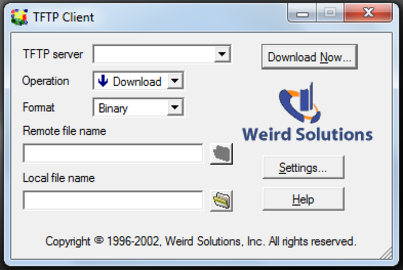- Ftp Client For Mac
- Tftp Client Mac Terminal
- Tftp Client For Mac Download
- Tftp Mac Os
- Tftp Client For Mac
Discuss: Using Terminal's tftp to update Linksys router in OS X Sign in to comment. Be respectful, keep it civil and stay on topic. We delete comments that violate our policy, which we encourage. Cyberduck is a file transfer client for Apple Mac and Microsoft Windows. Cyberduck is a fairly popular file transfer client for Apple Mac and Microsoft Windows. It supports FTP, SFTP, WebDAV, Amazon S3, OpenStack Swift, Backblaze B2, Microsoft Azure & OneDrive, Google Drive and Dropbox.
Configuring the TFTP server with TFTP Server v3.4.1:
Mac OS X has a built in TFTP server. However it can be challenging at times to configure and enable it.%nbsp;

%nbsp;
- Once the TFTP Server v3.4.1 is installed, launch the application.
- In the TftpServer application window, you can start or stop the TFTP service by clicking on the Start/Stop button: It will change its icon and text to reflect the server's status.
- Status is also visible at the bottom of theTftpServer window.
- Copy the firmware file(s) to folder/private/tftpboot
- /private/tftpboot is the default target folder for the TFTP server. If necessary, the target folder can be moved. Please see instructions below to relocate the target folder.
- Open the TFTP v3.4.1 application
- In the TftpServer window, click Start to enable the TFTP server if not already running
 After the firmware is updated, you can stop the TFTP server.
After the firmware is updated, you can stop the TFTP server.- Open the TFTP v3.4.1 application
- In the TftpServer window, click Stop to disable the TFTP server if the TFTP server if no longer needed
Manual configuration of TFTP server in Mac OS X:
Using TFTP Server on Mac OS X 10.7 Lion and later versions for firmware updates:- Copy the firmware file to folder/private/tftpboot
- /private/tftpbootis the default target folder for the TFTP server. If necessary, the target folder can be moved. Please see instructions below to relocate the target folder.
- Open Terminal
- In the terminal window, type the following two lines:
Ftp Client For Mac
Once the TFTP server is started, you may flash the VTrak via the CLI or CLU commands. Please see your user manual for firmware flash commands and instructions.
After the firmware is updated, you can disable the TFTP server.Stopping the TFTP server on Mac OS X 10.7 and later:- In the terminal window type:
Please note the TFTP server users UDP port 69 by default. If you have a firewall enabled on your system or network, be sure that UDP port 69 is not blocked and available during your update. Using TFTP Server on Mac OS X 10.6 Snow Leopard and earlier versions for firmware updates:
- Log in as root user on your Mac
- Copy the firmware file to folder/private/tftpboot
- /private/tftpboot is the default target folder for the TFTP server. If necessary, the target folder can be moved. Please see instructions below to relocate the target folder.
- Open Terminal
- In the terminal window type:
Once the TFTP server is started, you may flash the VTrak via the CLI or CLU commands. Please see your user manual for firmware flash commands and instructions.After the firmware is updated, you can disable the TFTP server.Stopping the TFTP server on Mac OS X 10.6 and earlier:
- In the terminal window opened in the steps above type:
Please note the TFTP server users UDP port 69 by default. If you have a firewall enabled on your system or network, be sure that UDP port 69 is not blocked and available during your update.
Changing the default TFTP folder:
- Open a Finder window
- Navigate to /System/Library/LaunchDaemons
- Using a plain text editor, modify tftp.plist
- Look for the following lines
| <key>ProgramArguments</key> |
| <array> |
| <string>/usr/libexec/tftpd</string> |
| <string>-i</string> |
| <string>/private/tftpboot</string> |
| </array> |
- Change the third <string> line from /private/tftpboot to another folder. This will move the TFTP server's target folder.
- For example, change the path to secure location like /var/tftpfiles
- Then make a new folder matching the change
| <key>ProgramArguments</key> |
| <array> |
| <string>/usr/libexec/tftpd</string> |
| <string>-i</string> |
| <string>/var/tftpfiles</string> |
| </array> |
Tftp Client Mac Terminal
- When done, save tftp.plist
- Now the TFTP server will look in /var/tftp_files folder for all TFTP file transfers
- You must either restart your Mac or restart the TFTP server to have the changes take effect.
On Windows I love the lightweight and open source TFTPD32, but there may come a time when you find youself needing to transfer some files and all you have is your trusty mac.
Luckily there’s a built in tftp daemon that you can use in a pinch.
By default tftpd uses the following folder:
which is hidden in finder, but can be accessed by using “go to folder” or hitting Command+Shift+G and entering /private/tftpboot
To launch the daemon run the following commands:
Tftp Client For Mac Download
Be sure Read/Write/eXecute permissions are set on the tftpboot folder and any files you wish to transfer:

Tftp Mac Os
If you’ll be transferring a file TO your TFTP server, the file will technically need to exist on the server beforehand so create it with touch. For example:
If you’d like a graphical front end for launching tftp then check out the great TftpServer.
Tftp Client For Mac
Now go ahead and get transferring.
